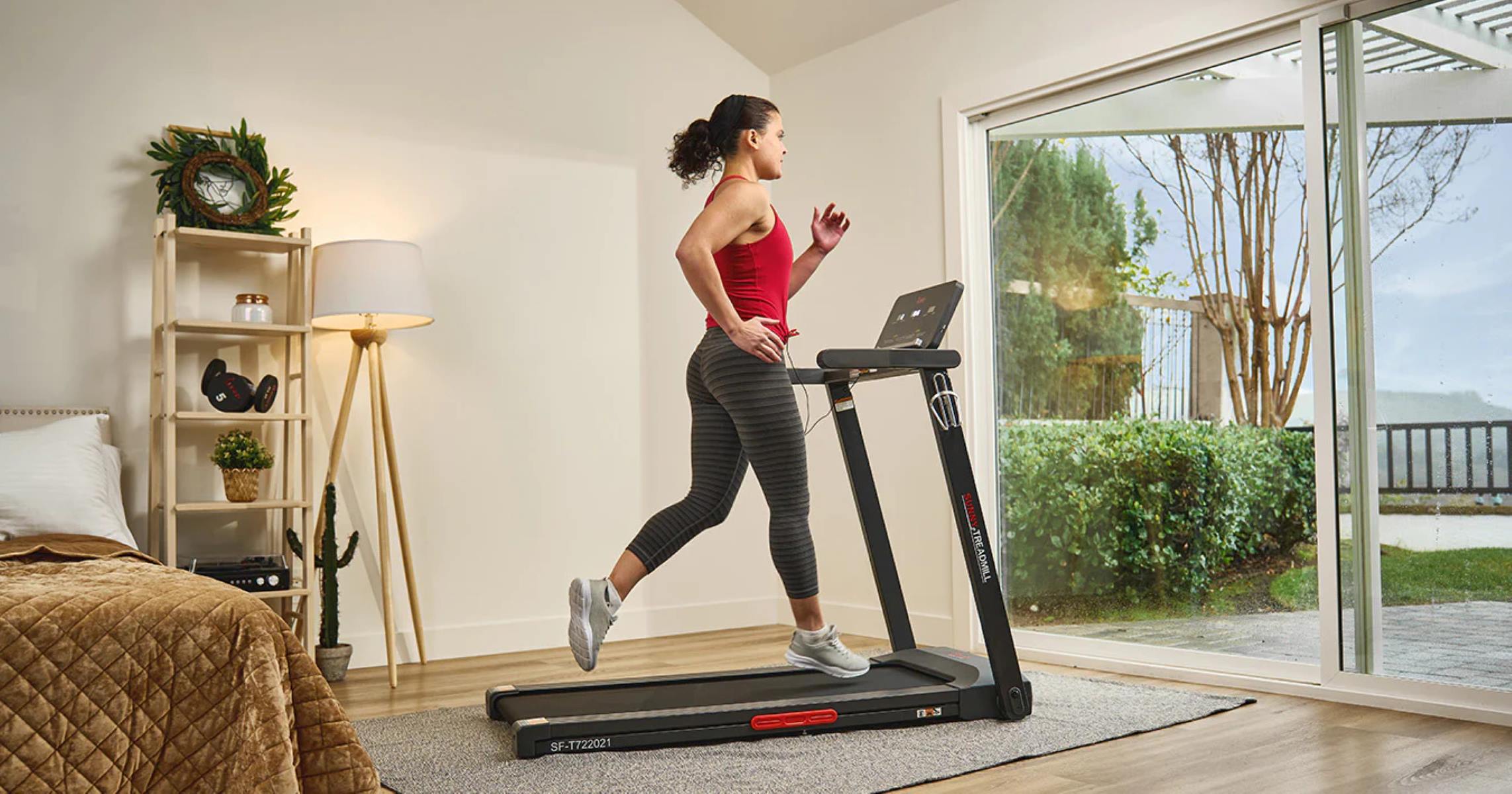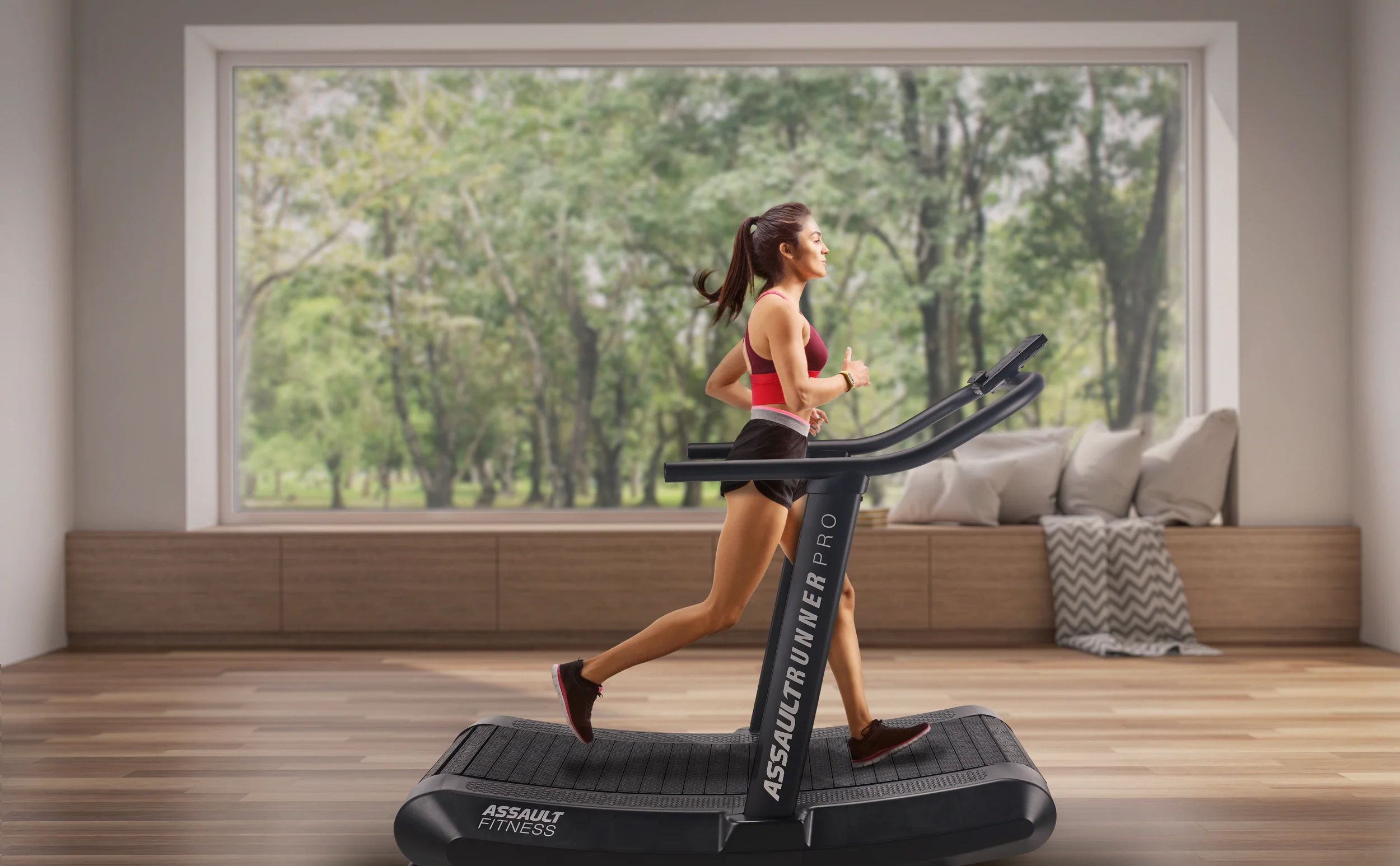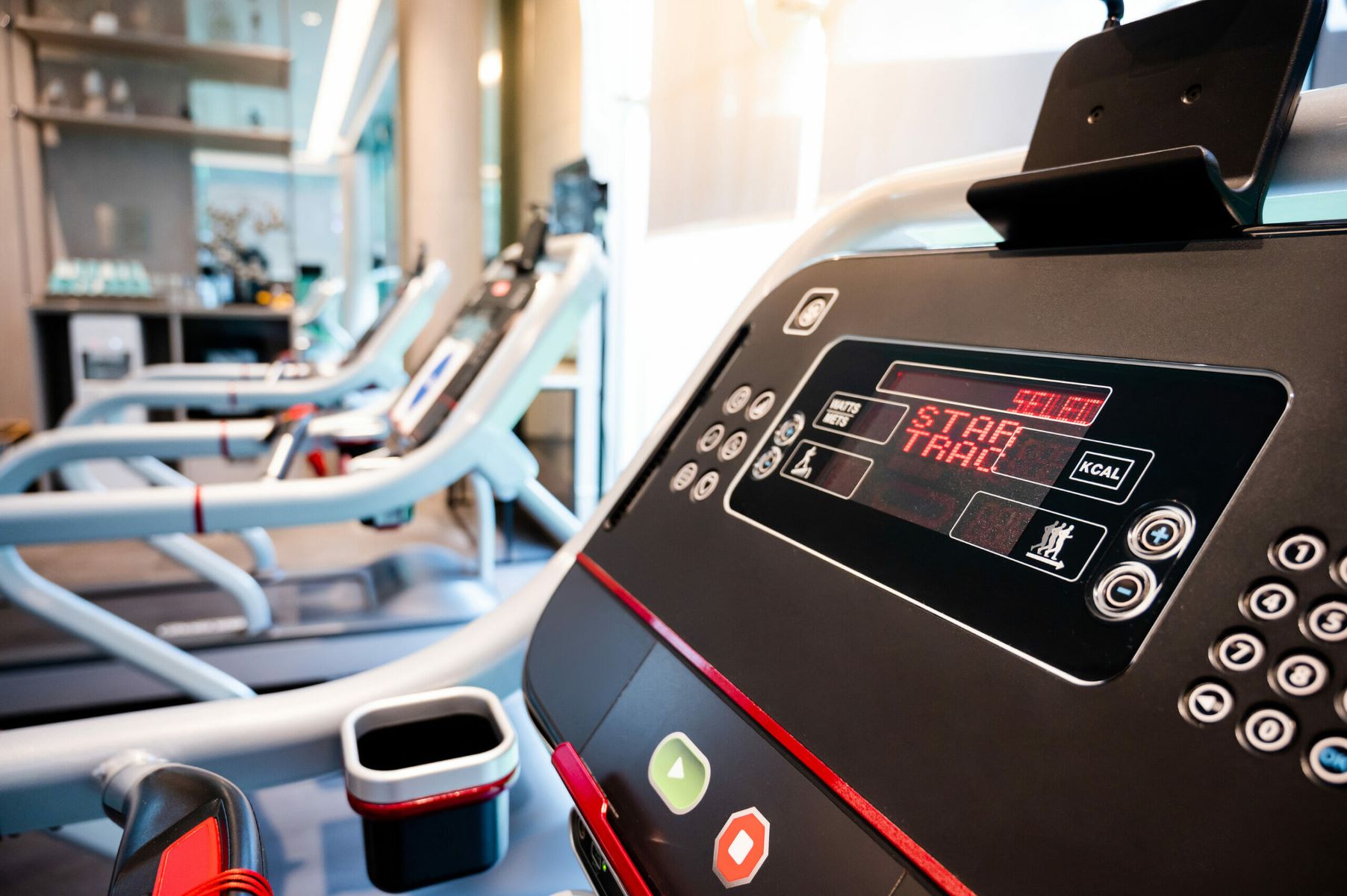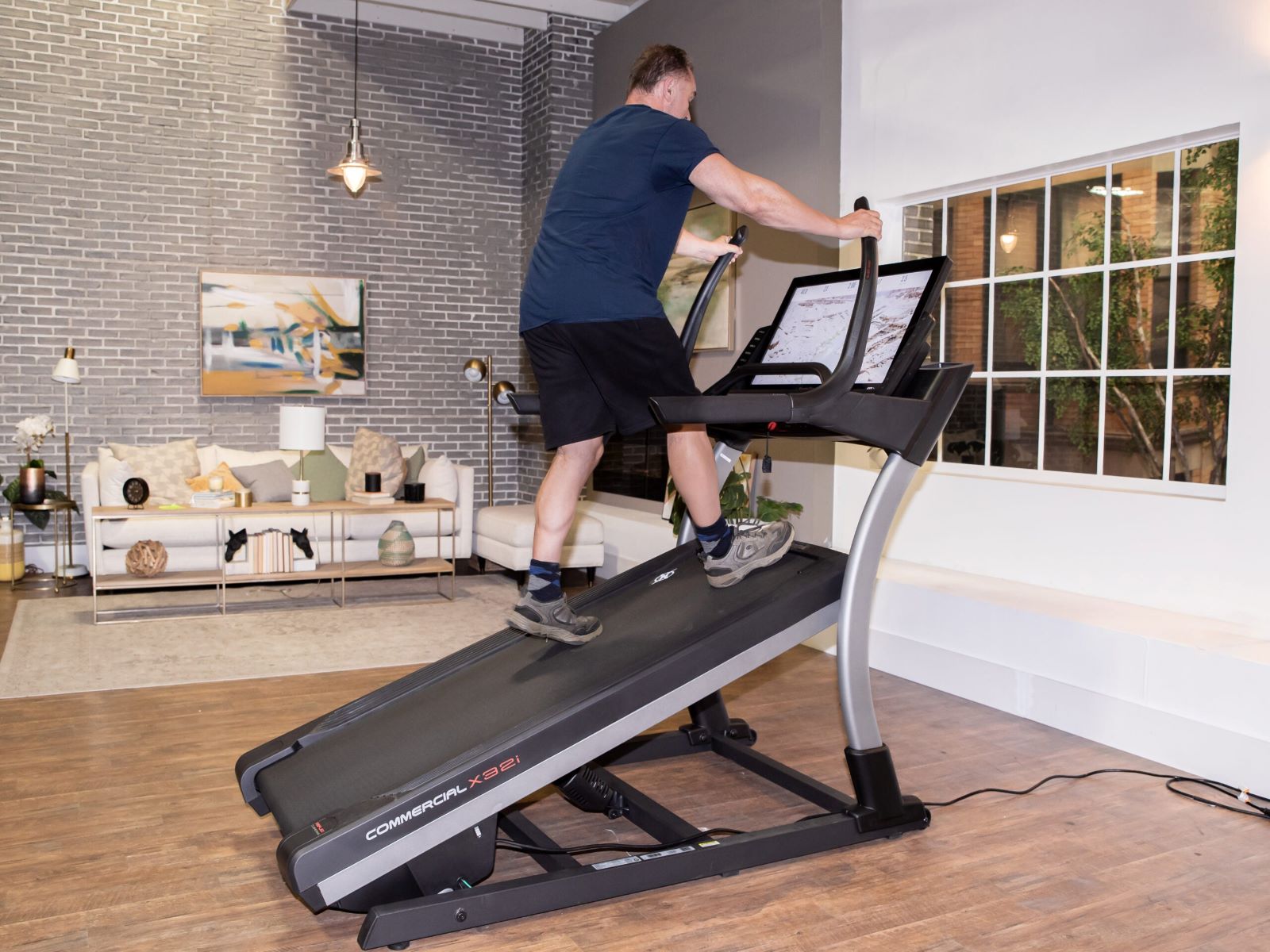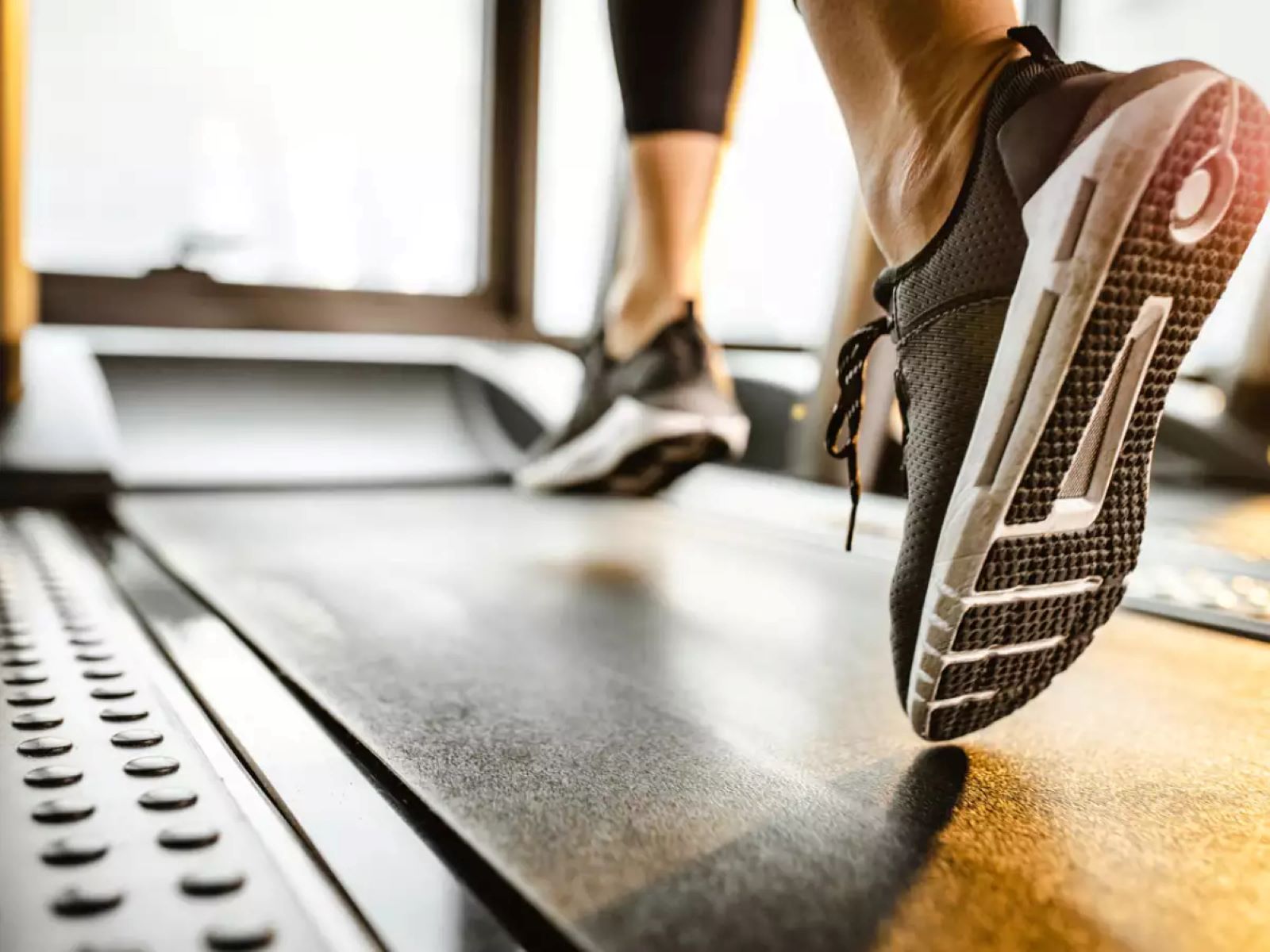

Featured
How To Burn Fat On Treadmill
Modified: August 21, 2023
Achieve your fitness goals with featured tips on how to burn fat on the treadmill. Start your journey to a healthier lifestyle today!
Introduction
Welcome to the world of treadmill workouts, where burning fat becomes a breeze! The treadmill is a versatile and effective piece of cardio equipment that can help you achieve your fitness goals, especially when it comes to shedding unwanted fat. Whether you’re a seasoned runner or just starting your fitness journey, the treadmill offers a convenient and controlled environment to burn calories and boost your metabolism.
In this article, we will explore the various techniques and strategies to maximize fat burning on a treadmill. From adjusting the settings and intensity levels to incorporating interval training and monitoring your heart rate, we will cover it all!
Burning fat on a treadmill has numerous benefits. Not only does it contribute to weight loss, but it also improves cardiovascular health, increases endurance, and tones your muscles. Moreover, treadmill workouts are accessible to people of all fitness levels, allowing you to tailor your exercise routine to suit your needs.
Before we dive into the specifics of burning fat on a treadmill, it’s important to note that fat loss is a gradual process that requires consistency, determination, and the right approach. With the right mindset and these proven techniques, you can optimize your treadmill workouts to burn fat effectively and efficiently.
In the following sections, we will guide you through each step of the process, from setting up the treadmill to tracking your progress and making adjustments along the way. So, lace up your sneakers, grab some water, and let’s get started on your journey to a healthier, fitter you!
Benefits of Burning Fat on Treadmill
Burning fat on a treadmill offers a plethora of benefits that go beyond just weight loss. Let’s explore some of the key advantages:
a. Weight Loss: One of the most obvious benefits of burning fat on a treadmill is weight loss. Treadmill workouts engage your entire body, making it a highly effective exercise for burning calories and shedding those extra pounds.
b. Cardiovascular Health: Regular treadmill workouts help improve cardiovascular health by strengthening the heart and increasing blood circulation. This can lower the risk of heart disease, lower blood pressure, and improve overall heart function.
c. Increased Endurance: Running or walking on a treadmill challenges your endurance, gradually increasing your stamina over time. By consistently pushing your limits, you’ll find that you can exercise for longer periods without feeling fatigued.
d. Muscle Toning: Treadmill workouts engage various muscle groups, including your quadriceps, hamstrings, glutes, and calves. As you consistently engage these muscles, they become stronger and more toned, giving you a leaner and more defined physique.
e. Convenience and Accessibility: Unlike outdoor running, the treadmill offers a controlled and predictable environment for your workouts. You can easily adjust the speed, incline, and intensity, making it accessible to people of all fitness levels. Plus, you can work out at any time of the day, regardless of weather conditions.
f. Improved Mental Well-being: Regular exercise on a treadmill releases endorphins, the “feel-good” hormones that boost your mood and reduce stress levels. It can also improve sleep quality, increase focus and concentration, and enhance overall mental well-being.
By incorporating treadmill workouts into your fitness routine, you can experience all these incredible benefits. It’s important to remember that consistency is key. Aim for at least 150 minutes of moderate-intensity aerobic activity or 75 minutes of vigorous-intensity aerobic activity per week, as recommended by the American Heart Association.
Now that we understand the benefits, let’s move on to the next section, where we’ll learn about setting up and adjusting the treadmill for an effective fat-burning workout.
Setting and Adjusting the Treadmill
Before diving into your fat-burning treadmill workout, it’s essential to properly set up and adjust the treadmill to ensure a safe and effective exercise session. Here’s what you need to do:
a. Safety First: Start by familiarizing yourself with the safety features of the treadmill. Locate the emergency stop button and make sure it is easily accessible in case you need to stop the treadmill quickly. Also, ensure that the area around the treadmill is clear of any objects or obstacles.
b. Proper Placement: Place your treadmill on a sturdy and level surface, preferably with some cushioning underneath to reduce impact. Make sure it is positioned in a well-ventilated area with enough space around it for you to move freely.
c. Adjusting the Incline: Most treadmills allow you to adjust the incline to simulate outdoor terrain. Start with a flat surface and gradually increase the incline as you progress. A moderate incline engages more muscles and increases the calorie burn during your workout.
d. Speed Settings: Set your treadmill to a comfortable walking or jogging speed to begin with. As you warm up and get more comfortable, you can gradually increase the speed. Aim for a pace that challenges you and elevates your heart rate, but still allows you to maintain good form.
e. Selecting a Program: Many treadmills come with pre-set workout programs that vary in intensity and duration. These programs can provide a structured and varied workout experience. Experiment with different programs to find the ones that align with your fitness goals.
f. Safety Guidelines: Always use the treadmill’s safety clip or safety key, which attaches to your clothing and stops the treadmill if you fall or lose balance. It’s also important to maintain proper posture while using the treadmill. Keep your head up, shoulders relaxed, and your arms swinging naturally.
g. Listening to Your Body: Pay attention to how your body feels during the workout. If you experience any pain or discomfort, stop immediately. It’s better to listen to your body and make necessary adjustments rather than risking injury.
By following these guidelines, you can ensure a safe and efficient treadmill workout. Now that we have everything set up, let’s move on to the next section, where we’ll discuss warm-up exercises to prepare your body for the fat-burning workout ahead.
Warm-Up Exercises
Before diving into the intense fat-burning portion of your treadmill workout, it’s crucial to properly warm up your body. Warm-up exercises help increase blood flow to your muscles, raise your core body temperature, and prepare your body for the upcoming workout. Here are some effective warm-up exercises to incorporate before hitting the treadmill:
a. Dynamic Stretching: Start with dynamic stretches that involve continuous movement, such as leg swings, arm circles, and walking lunges. These stretches help improve flexibility, increase joint range of motion, and activate the muscles you’ll be using during your workout.
b. Walking or Slow Jog: Begin your warm-up by walking at a brisk pace or performing a slow jog on the treadmill for about 5-10 minutes. This helps gradually elevate your heart rate, warm up your muscles, and loosen your joints.
c. High Knees: Stand tall and march on the spot, lifting your knees as high as possible. This exercise helps activate your hip flexors, quadriceps, and core muscles while improving coordination.
d. Butt Kicks: Stand with your feet hip-width apart and jog in place while kicking your heels up towards your glutes. This exercise helps warm up your hamstrings and calves while improving flexibility and range of motion.
e. Leg Swings: Hold onto a sturdy object for support and swing one leg forward and backward, keeping it straight. Alternate between legs for a few sets. This exercise helps loosen your hips, hamstrings, and hip flexors.
f. Arm Circles: Stand with your feet shoulder-width apart and extend your arms out to the sides. Start making small circles with your arms, gradually increasing the size of the circles. Reverse the direction after a few rotations. This exercise helps warm up your shoulder joints and upper body.
g. Core Activation: Perform exercises like planks or standing side bends to engage your core muscles and stabilize your torso. A strong core is essential for maintaining proper posture and balance during your treadmill workout.
Remember: The purpose of the warm-up is to gradually increase your heart rate and prepare your body for more intense exercise. Take your time and listen to your body. If any exercise feels uncomfortable or causes pain, modify it or choose an alternative exercise.
By incorporating these warm-up exercises into your treadmill routine, you’ll enhance your performance, reduce the risk of injury, and optimize your fat-burning potential. Now that we’re warmed up, let’s move on to the next section, where we’ll discuss how to choose the right intensity level for your fat-burning workout.
Choosing the Right Intensity Level
Choosing the right intensity level for your treadmill workout is crucial to maximize fat burning and prevent overexertion. The intensity level refers to how hard you’re working during your exercise session. Finding the sweet spot that challenges you without pushing you to your limits is key. Here’s how to choose the right intensity level:
a. Rate of Perceived Exertion (RPE): One way to gauge the intensity level is by using the Rate of Perceived Exertion scale, which ranges from 1 to 10. 1 represents minimal effort, while 10 represents maximum effort. Aim for an RPE of around 5 to 7, where you’re working hard, but still able to carry on a conversation without gasping for breath.
b. Talk Test: Another method to determine intensity is the talk test. If you’re able to speak in full sentences without struggling for breath, you’re likely at a moderate intensity level. If you can only speak in short phrases or gasps, you may be pushing too hard. Adjust your speed or incline accordingly.
c. Heart Rate Monitoring: Monitoring your heart rate is an excellent way to objectively measure your exercise intensity. Calculate your maximum heart rate by subtracting your age from 220. During your treadmill workout, aim for a heart rate that is around 50-70% of your maximum heart rate for fat-burning benefits.
d. Perceived Effort: Pay attention to how your body feels during the workout. If you feel like you’re working hard but still able to maintain good form and breathing, you’re likely at the right intensity. If you’re extremely uncomfortable or experiencing pain, dial back the intensity level.
e. Interval Training: Incorporating interval training is an effective way to vary the intensity of your workouts. Interval training involves alternating between high-intensity bursts and lower-intensity recovery periods. This method allows you to work at a higher intensity during the bursts while still giving your body time to recover.
Remember: Everyone’s fitness level is different, so what may be challenging for one person may be too easy or too difficult for another. It’s essential to listen to your body and make adjustments accordingly. Gradually increase the intensity as your fitness improves and your body becomes accustomed to the workouts.
By choosing the right intensity level, you’ll optimize your fat-burning potential and make your treadmill workouts more effective. In the next section, we’ll explore the concept of interval training and how you can incorporate it into your routine for maximum fat burn.
Interval Training for Maximum Fat Burn
If you’re looking to maximize fat burn and elevate your treadmill workouts to the next level, incorporating interval training is the way to go. Interval training involves alternating between high-intensity bursts and recovery periods, allowing you to push your limits and burn more calories in a shorter amount of time. Here’s how you can incorporate interval training into your routine:
a. Choose Your Work-to-Rest Ratio: Decide on the work-to-rest ratio that suits your fitness level and goals. For beginners, start with a 1:2 ratio, which means that for every high-intensity interval, you have twice as long for recovery. As you progress, you can adjust the ratio to challenge yourself further.
b. Warm Up: Begin with a 5-10 minute warm-up at a moderate pace to prepare your body for the upcoming intervals. This helps elevate your heart rate, increase blood flow to your muscles, and prevent injury.
c. High-Intensity Interval: Increase the speed or incline to a challenging level and maintain it for the designated interval duration. Push yourself to work at a high intensity, putting in maximum effort and giving it your all. This could range from 20 seconds to several minutes, depending on your fitness level and goals.
d. Recovery Period: After each high-intensity interval, recover by either decreasing the speed or incline or returning to a comfortable walking or jogging pace. Use this recovery period to catch your breath, lower your heart rate, and prepare for the next interval.
e. Repeat the Cycle: Continue alternating between high-intensity intervals and recovery periods for a predetermined number of repetitions or a set time frame. Aim to complete at least 4-6 intervals during your workout to experience the full fat-burning benefits of interval training.
f. Cool Down: Finish your interval training session with a 5-10 minute cool down period, gradually decreasing your speed and allowing your body to recover. This helps prevent muscle soreness and promotes efficient recovery.
Important: Interval training is intense, so it’s crucial to listen to your body and gradually increase the intensity as you become fitter. Don’t sacrifice proper form for speed or intensity, as this can lead to injury. If you’re new to interval training, start with shorter intervals and longer recovery periods, gradually increasing the intensity and duration over time.
By incorporating interval training into your treadmill workouts, you’ll experience increased calorie burn, improve cardiovascular fitness, and enhance your body’s ability to burn fat. In the next section, we’ll explore how incorporating incline can amplify your fat-burning efforts on the treadmill.
Incorporating Incline for Increased Intensity
If you’re looking to take your fat-burning treadmill workouts up a notch, incorporating incline can be a game-changer. Adding incline to your workouts increases the intensity, engages different muscle groups, and burns more calories. Here’s how you can effectively incorporate incline into your treadmill routine:
a. Start with a Flat Surface: Begin your treadmill workout with a flat surface to warm up and get your body prepared. This allows you to establish a steady pace and familiarize yourself with the treadmill.
b. Gradually Increase the Incline: Once you’re comfortable, start gradually increasing the incline. Aim for a hill-like effect, challenging your muscles and causing them to work harder. Begin with a slight incline of 1-3%, and gradually increase it as your fitness level improves.
c. Maintain Good Form: When using incline, it’s important to maintain good form. Keep your head up, shoulders relaxed, and core engaged. Avoid leaning too far forward or holding onto the front handlebars for support. This ensures that your muscles are working effectively and reduces the risk of injury.
d. Adjust Speed Accordingly: As the incline increases, you may need to adjust your speed to maintain a comfortable and challenging pace. Find a balance between speed and incline that allows you to work at an intensity that raises your heart rate and challenges your muscles.
e. Utilize Incline Intervals: Similar to interval training, you can incorporate incline intervals into your workout. Alternate between periods of higher incline and periods of a flat surface or lower incline. This adds variety, makes the workout more challenging, and helps you burn more calories in a shorter amount of time.
f. Listen to Your Body: Pay attention to how your body feels while using incline. If you experience any pain or discomfort, decrease the incline or take a break. It’s essential to listen to your body and adjust the intensity to a level that is challenging yet safe.
Remember: Incline training targets different muscle groups, particularly your glutes, hamstrings, and calves, while also increasing cardiovascular demand. It can amplify the calorie burn, improve endurance, and help you achieve your fat-burning goals.
Now that you know how to incorporate incline effectively, let’s move on to the next section, where we’ll discuss the importance of monitoring your heart rate during your fat-burning treadmill workout.
Monitoring Heart Rate for Effective Fat Burning
Monitoring your heart rate during your treadmill workout is a valuable tool for ensuring that you’re in the optimal fat-burning zone. By understanding and tracking your heart rate, you can adjust the intensity of your workout to maximize fat burn. Here’s why monitoring your heart rate is important and how you can do it effectively:
a. The Fat-Burning Zone: Your heart rate dictates the energy source your body relies on during exercise. By staying within the fat-burning zone, typically around 60-70% of your maximum heart rate, your body primarily burns stored fat for fuel. This helps you achieve your fat loss goals more effectively.
b. Calculate Your Maximum Heart Rate: To determine your target heart rate range for fat burning, you need to know your maximum heart rate (MHR). Subtract your age from 220 to estimate your MHR. Then, calculate 60-70% of your MHR to determine your target heart rate range.
c. Use a Heart Rate Monitor: Investing in a heart rate monitor or using the ones integrated into treadmills or fitness trackers can provide real-time feedback on your heart rate. This allows you to stay within the desired range and adjust your intensity as needed during your workout.
d. Pay Attention to Perceived Exertion: In addition to using a heart rate monitor, consider your perceived exertion level during the workout. If you’re unable to maintain a conversation or feel extremely fatigued, you may be exceeding your target heart rate range. Adjust the intensity accordingly.
e. Gradually Increase Intensity: As your fitness level improves, you may find that you need to increase the intensity to keep your heart rate in the fat-burning zone. Gradually increase the speed, incline, or both, to challenge your cardiovascular system and continue burning fat efficiently.
f. Remember Individual Variations: It’s important to note that everyone’s heart rate response to exercise differs. Factors like age, fitness level, medications, and genetics can influence heart rate. Therefore, it’s essential to use heart rate guidelines as a general reference and adjust accordingly based on your comfort level and overall fitness goals.
Monitor Your Progress: Regularly monitoring your heart rate during treadmill workouts helps gauge the effectiveness of your fat-burning routine. Over time, you may notice improvements in your heart rate recovery, indicating improved cardiovascular fitness and enhanced fat-burning capabilities.
By monitoring your heart rate and staying within the fat-burning zone, you can optimize your treadmill workouts to burn more fat and achieve your fitness goals. In the next section, we’ll explore the benefits of incorporating HIIT (High-Intensity Interval Training) into your fat-burning treadmill routine.
Incorporating HIIT (High-Intensity Interval Training)
When it comes to maximizing fat burn and pushing your limits on the treadmill, High-Intensity Interval Training (HIIT) is a highly effective approach. HIIT involves short bursts of intense exercise followed by brief recovery periods. This method elevates your heart rate, increases calorie burn, and boosts your metabolism long after your workout. Here’s how you can incorporate HIIT into your fat-burning treadmill routine:
a. Choose Your Work-to-Rest Ratio: Determine the work-to-rest ratio that suits your fitness level and preferences. Start with a 1:1 ratio, where your high-intensity interval is followed by an equal duration of recovery. As you progress, you can experiment with different ratios like 2:1 or even 3:1 for more challenging workouts.
b. Warm Up: Begin with a 5-10 minute warm-up at a moderate pace to prepare your body for the upcoming HIIT intervals. This helps increase blood flow to your muscles and lowers the risk of injury.
c. High-Intensity Interval: Increase the speed or incline to a challenging level and perform a high-intensity exercise for a short duration, typically 20-60 seconds. This could include running at a sprint pace, performing fast-paced jump squats, or any other explosive exercises that get your heart racing.
d. Recovery Period: After each high-intensity interval, recover by reducing the speed or incline and taking a brief rest period. This allows your heart rate to come down slightly before the next round of intense exercise.
e. Repeat the Cycle: Continue alternating between high-intensity intervals and brief recovery periods for the desired number of repetitions or time frame. Aim to complete at least 4-6 intervals during your workout to reap the full benefits of HIIT.
f. Cool Down: Finish your HIIT treadmill session with a 5-10 minute cool down period, gradually decreasing your speed and allowing your body to recover. This helps lower your heart rate, prevent muscle soreness, and promote efficient recovery.
Important: HIIT is demanding, and it’s crucial to listen to your body. Start with shorter intervals and longer recovery periods, gradually increasing the intensity and duration over time. If you’re new to HIIT or have any underlying health conditions, consult with your healthcare provider before incorporating this training approach into your routine.
Incorporating HIIT into your fat-burning treadmill routine offers several benefits. It helps improve cardiovascular fitness, enhances the body’s ability to burn fat, and saves time due to the high-calorie burn in shorter workout durations. Additionally, the metabolic boost from HIIT can continue to increase calorie burn even after you have finished exercising.
Now that you’re familiar with HIIT on the treadmill, we’ll move on to the next section, where we’ll discuss the importance of incorporating cool-down exercises into your fat-burning routine.
Cool Down Exercises
Cooling down after your fat-burning treadmill workout is just as important as the warm-up and exercise itself. A proper cool down allows your heart rate and breathing to gradually return to normal, reduces muscle soreness, and promotes the efficient recovery of your body. Here are some beneficial cool down exercises to incorporate into your routine:
a. Slow Walking or Jogging: Begin by gradually decreasing your speed and transitioning into a slow walk or light jog. This brings your heart rate down gradually and helps to prevent blood from pooling in your legs.
b. Gentle Stretching: Perform static stretches by targeting the major muscle groups you used during your treadmill workout. Focus on stretching your calves, quadriceps, hamstrings, hip flexors, and upper body muscles. Hold each stretch for around 20-30 seconds without bouncing.
c. Deep Breathing and Relaxation: Take a few moments to practice deep breathing exercises to help promote relaxation and reduce any tension in your muscles. Inhale deeply through your nose, and exhale slowly through your mouth, allowing any stress or fatigue to dissipate.
d. Foam Rolling or Self-Myofascial Release: Consider using a foam roller or massage ball to target any tense or tight areas of your body. This technique known as self-myofascial release helps relieve muscle tension, improves flexibility, and aids in muscular recovery.
e. Hydration: Drink plenty of water during your cool down to replenish fluids lost during exercise. Staying hydrated is essential for optimal recovery and maintaining overall health.
f. Reflect and Record: Take a moment to reflect on your workout, noting any aspects that went well or areas you’d like to improve upon for future sessions. Consider recording your workout details in a journal or fitness tracker to track your progress over time.
Cooling down properly can help reduce the risk of muscle cramps, dizziness, or feeling lightheaded after exercise. It also allows your body to transition from a high-intensity workout state to a state of rest more smoothly.
Remember, cooling down is about gradually decreasing your heart rate and allowing your body to recover. So, take the time to include these cool down exercises into your treadmill routine and give your body the attention it deserves.
In the final section, we’ll discuss some additional tips and considerations to help you optimize your fat-burning treadmill workouts.
Tracking Progress and Adjusting Routine
Tracking your progress and adjusting your routine is crucial for continual improvement and maximizing the effectiveness of your fat-burning treadmill workouts. By monitoring your achievements and making necessary adjustments, you can stay motivated and ensure ongoing progress. Here’s how you can track your progress and make necessary adjustments to your routine:
a. Set Measurable Goals: Start by setting specific, measurable, achievable, relevant, and time-bound (SMART) goals that align with your fat-burning objectives. Whether it’s losing a certain amount of weight or increasing your running distance, having tangible goals provides a benchmark for tracking progress.
b. Use a Fitness Tracker or App: Utilize technology by using fitness trackers or mobile applications to monitor various metrics like distance covered, calorie burn, heart rate, and workout duration. These tools can provide valuable insights and help you track your progress over time.
c. Record Your Workouts: Keep a workout journal or use the notes section in your fitness tracker to document details about each treadmill session, including the duration, intensity, speed, incline, and any additional notes about how you felt during and after the workout. This record allows you to look back and identify patterns or adjustments that need to be made.
d. Track Body Measurements: In addition to tracking your treadmill performance, consider measuring other body metrics like weight, body fat percentage, or waist circumference. These measurements can provide a more comprehensive overview of your progress and body composition changes.
e. Progression and Gradual Adjustments: As you become fitter, gradually increase the intensity, duration, or frequency of your treadmill workouts to continue challenging your body. This progression helps prevent plateauing and ensures that you keep pushing your limits for optimal fat burning.
f. Listen to Your Body: Pay attention to how your body responds to each workout. If you consistently feel fatigued or experience pain or discomfort, it may be a sign that you need to adjust the intensity, duration, or recovery periods. Remember, it’s crucial to prioritize safety and avoid overtraining.
g. Seek Variety: Incorporate variety into your treadmill workouts to keep them engaging and prevent boredom. Experiment with different incline levels, speeds, interval durations, or workout programs offered by your treadmill or fitness tracker. This not only adds excitement but also challenges different muscle groups for a well-rounded workout.
By tracking your progress and making necessary adjustments to your routine, you’ll be able to continually challenge yourself, break through plateaus, and achieve your fat-burning goals. Remember that progress takes time, so stay patient, consistent, and committed to your fitness journey.
Now that you’re equipped with these tips, it’s time to apply them and take your fat-burning treadmill workouts to the next level!
Additional Tips and Considerations
As you continue your fat-burning journey on the treadmill, there are some additional tips and considerations that can help you optimize your workouts and achieve your goals. Keep these in mind to enhance your overall treadmill experience:
a. Stay Consistent: Consistency is key when it comes to burning fat and improving fitness. Aim for regular treadmill sessions, whether it’s three times a week or more, to maximize results and maintain progress over time.
b. Incorporate Resistance Training: Don’t forget about the benefits of resistance training. Add strength training exercises like bodyweight exercises, dumbbell routines, or weightlifting to your regimen to build lean muscle mass, which can increase your body’s metabolism and aid in fat burning.
c. Prioritize Recovery: Allow your body ample time to recover between treadmill workouts. Incorporate rest days into your routine to prevent overtraining, reduce the risk of injury, and give your muscles the chance to repair and rebuild.
d. Fuel Yourself Properly: Proper nutrition plays a crucial role in supporting your fat-burning efforts. Fuel your body with a balanced diet consisting of lean proteins, healthy fats, complex carbohydrates, and plenty of fruits and vegetables. Stay adequately hydrated before, during, and after your workouts.
e. Mix Up Your Routine: Don’t be afraid to mix up your treadmill routine with other forms of cardio exercise or outdoor activities. This variety not only prevents boredom but also challenges your body in different ways, improving overall fitness and fat-burning potential.
f. Seek Professional Guidance: If you’re new to exercise or have specific health concerns, consider consulting with a certified personal trainer or fitness professional who can help design a safe and effective fat-burning treadmill routine tailored to your individual needs.
g. Enjoy the Process: Lastly, remember to enjoy the process and have fun with your workouts. Find ways to stay motivated, such as creating motivating playlists, watching your favorite shows during treadmill sessions, or exercising with a workout buddy. The more enjoyable your workouts are, the more likely you’ll stick with them in the long run.
Keep these additional tips and considerations in mind as you continue your fat-burning journey on the treadmill. Stay focused, motivated, and committed to your goals, and you’ll see the results you desire. Remember, consistency and a positive mindset are key ingredients for success!
Conclusion
Congratulations on completing this comprehensive guide to burning fat on the treadmill! By incorporating the strategies and techniques outlined throughout the article, you now have the knowledge to optimize your treadmill workouts and maximize fat-burning potential.
We explored the numerous benefits of treadmill workouts, from weight loss and cardiovascular health to increased endurance and muscle toning. By setting up and adjusting the treadmill correctly, incorporating warm-up exercises, choosing the right intensity level, and implementing interval training and incline, you can make your workouts more efficient and effective.
Monitoring your heart rate, incorporating HIIT, cooling down properly, and tracking your progress are all key elements to ensure continued progress and improvement. Additionally, considering factors like adjusting your routine, incorporating resistance training, and prioritizing recovery will contribute to your long-term success.
Remember, fitness is a journey, and results take time. Stay dedicated, be patient with yourself, and celebrate each milestone along the way. Find joy and motivation in the process, and remember that consistency and a positive mindset are essential for long-term success.
Now that you’re armed with a wealth of knowledge and strategies, it’s time to put them into action. Lace up your shoes, step onto the treadmill, and embark on your fat-burning journey. With each step, you’re getting closer to achieving your goals and becoming a healthier, fitter version of yourself.
So, go ahead, embrace the challenge, and keep pushing your limits on the treadmill. Your body will thank you for it!
